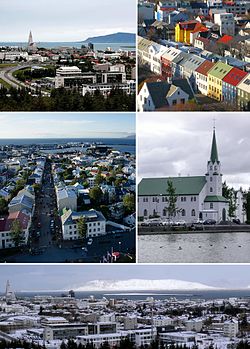Reykjavík, Iceland
| Reykjavík | |
|---|---|

From upper left: Reykjavik from Perlan, rooftops from Hallgrímskirkja, Reykjavik from Hallgrímskirkja, Fríkirkjan, panorama from Perlan
|
|

Coat of arms of Reykjavík
|
|

Location of Reykjavík
|
|
| Region | Capital Region |
| Constituency |
Reykjavík Constituency North Reykjavík Constituency South |
| Market right | August 18, 1786 |
| Mayor | Dagur Bergþóruson Eggertsson (SDA) |
| Council | Reykjavík City Council |
| Area | 273 km2 (105 sq mi) |
| Population | 123 246 (2016) |
| Density | 451.5/km2 (1,169/sq mi) |
| Municipal number | 0000 |
| Postal code(s) | 101–155 |
| Website |
reykjavik |
| Largest groups of foreign residents | |
| Nationality | Population (2015) |
|---|---|
|
|
3,589 |
|
|
871 |
|
|
397 |
|
|
365 |
|
|
345 |
|
|
344 |
|
|
338 |
|
|
322 |
|
|
285 |
|
|
267 |
Reykjavík (/ˈreɪkjəvɪk, -viːk/ RAYK-yə-vik, RAYK-yə-veek; Icelandic: [ˈreiːcaˌviːk]) is the capital and largest city of Iceland. It has a latitude of 64°08' N, making it the world's northernmost capital of a sovereign state, and is a popular tourist destination. It is located in southwestern Iceland, on the southern shore of Faxa Bay. With a population of around 123 300 (and over 216 940 in the Capital Region), it is the heart of Iceland's cultural, economic and governmental activity.
Reykjavík is believed to be the location of the first permanent settlement in Iceland, which, according to Ingólfur Arnarson, was established in AD 874. Until the 19th century, there was no urban development in the city location. The city was founded in 1786 as an official trading town and grew steadily over the next decades, as it transformed into a regional and later national centre of commerce, population, and governmental activities. It is among the cleanest, greenest, and safest cities in the world.
...
Wikipedia
